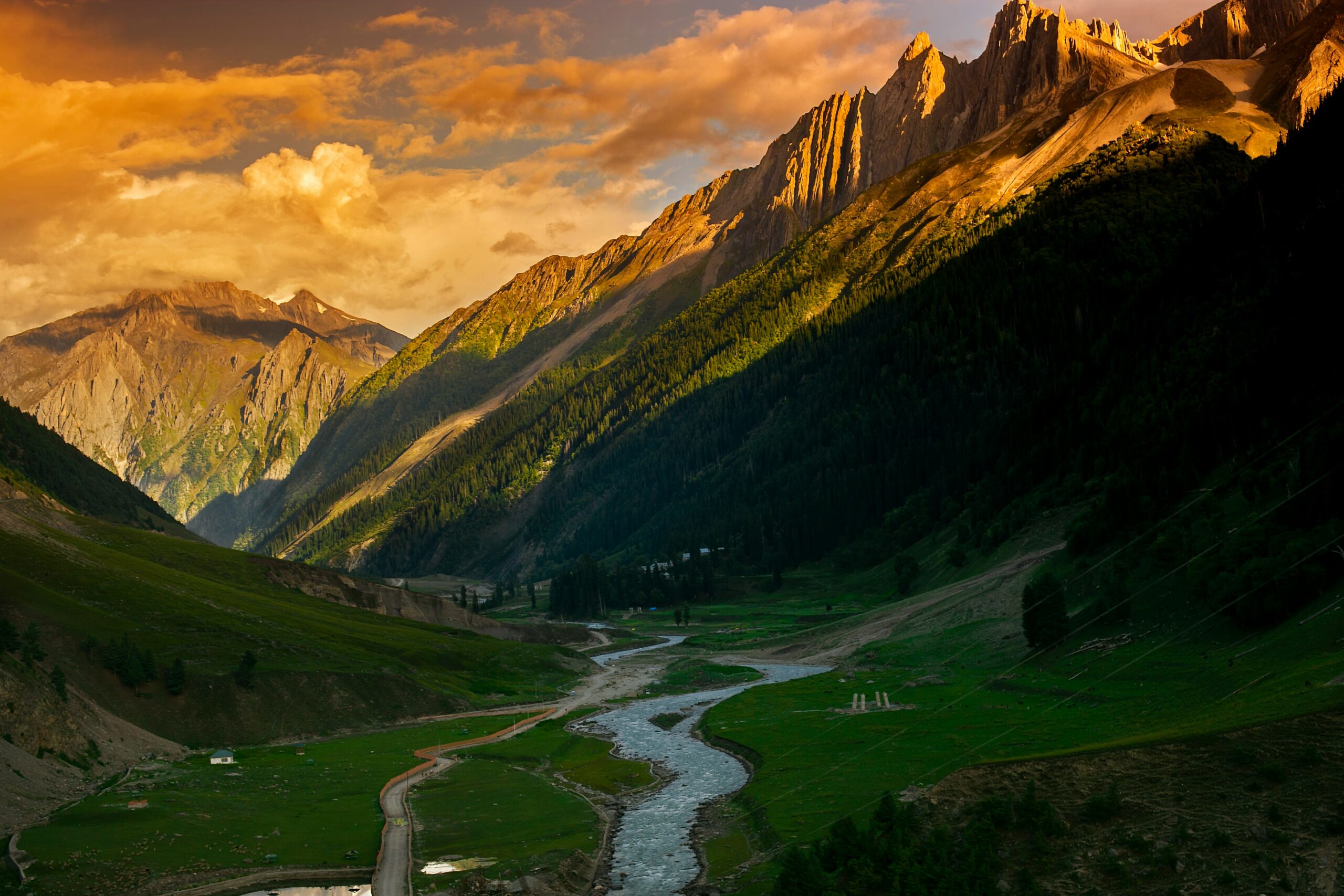Introduction to Jammu
Jammu, nestled in the northern part of India, serves as a prominent entry point to the captivating Union Territory of Jammu and Kashmir. This region is renowned not just for its breathtaking landscapes, which seamlessly merge the rugged mountains and lush valleys, but also for its rich and diverse cultural heritage. Jammu holds the distinction of being the winter capital of the Union Territory, a status that underlines its significance in the socio-political framework of the region.
Geographically, Jammu is positioned on the banks of the Tawi River and is surrounded by the majestic Pir Panjal range, offering stunning views that attract both domestic and international travelers. The climate in Jammu varies significantly throughout the year, with hot summers, pleasant springs, and chilly winters inviting a broad spectrum of tourism activities. Visitors can expect to experience everything from serene nature trails to vibrant local festivals that showcase the artistic flair and traditional customs of the region.
The historical significance of Jammu cannot be overstated, as it has been a hub of cultural interactions and exchanges for centuries. Many ancient temples, palaces, and heritage sites testify to its storied past. Amongst the attractions, the revered Raghunath Temple and the grand Mubarak Mandi Palace stand out, illustrating the architectural finesse of yesteryears, while also reflecting the spiritual ethos of the society. This unique blend of history and spirituality amplifies Jammu’s charm, making it a desirable destination for those seeking both enlightenment and adventure.
As we embark on a journey to explore Jammu, it becomes essential to appreciate not only its natural beauty but also its cultural richness. From the warmth of its people to the tantalizing local cuisine, Jammu promises an enchanting experience, inviting visitors to uncover its many facets.
Historical Significance of Jammu
Jammu holds a profound historical significance that can be traced back to ancient times, establishing it as a pivotal center of culture and governance in the region. Its history is intricately woven with various dynasties that have influenced its development, leaving behind a rich tapestry of traditions and landmarks. Initially, Jammu served as a strategic location for the Rajput rulers, who recognized its potential as a fortified settlement due to its geographic advantages. The historical narratives depict Jammu as a flourishing hub of trade and cultural exchange.
One of the notable dynasties that played a crucial role in shaping Jammu’s history was the Dogra dynasty, which rose to prominence in the 19th century under Maharaja Gulab Singh. His establishment of the princely state of Jammu and Kashmir marked a turning point, modernizing the region and enhancing its status within India. The contributions of the Dogra rulers can still be felt today, particularly through the architectural marvels and temples that dot the landscape.
Among the significant landmarks is the Raghunath Temple, dedicated to Lord Rama, which stands as a testament to the architectural brilliance of the time. Established in the 19th century, this temple not only serves as a key religious site but also reflects the artistic and cultural ethos of the era. Additionally, the Ranbireshwar Temple, dedicated to Lord Shiva, showcases intricate carvings and is a symbol of devotion for many devotees. These temples, along with various forts and palaces, embody the historical significance of Jammu and contribute to its identity, painting a picture of a region rich in heritage.
As a gateway to the beautiful landscapes of Kashmir, the historical backdrop of Jammu enriches its status as a destination of cultural importance, attracting historians and travelers alike who seek to explore its majestic history.
Cultural Richness and Festivals
Jammu, often referred to as the “Gateway to Paradise,” is a region steeped in cultural richness that reflects a unique blend of traditions, languages, and art forms. The cultural tapestry of Jammu is woven from various influences, with its inhabitants practicing a multitude of religions and speaking numerous languages, including Dogri, Hindi, Punjabi, and Urdu. This diversity is evident in the local customs and daily life, where age-old traditions coexist harmoniously with modern practices.
One of the most vibrant aspects of Jammu’s culture is its festivals, which bring together communities and showcase the region’s heritage. Baisakhi, a harvest festival celebrated in April, symbolizes the beginning of the new harvest season and is marked by lively fairs, traditional dances, and feasting. Similarly, Lohri, celebrated in January, is dedicated to the Sun God, inviting families to gather around bonfires to enjoy songs, dances, and sweets. These festivals not only reflect the agricultural significance of the region but also serve as platforms that foster community spirit and togetherness.
The Jammu Winter Carnival, held annually, is another testament to the region’s enthusiasm for cultural celebration. This event attracts both locals and tourists with its vibrant displays of music, dance, and art. The carnival features performances from local artists, traditional craft exhibitions, and various competitions, allowing attendees to immerse themselves in the rich cultural heritage of Jammu. Each of these festivals demonstrates the warmth and unity of the local community while highlighting the artistic expressions found within the region.
Through its numerous festivals and rich cultural practices, Jammu stands out as a vibrant area where tradition meets modernity, making it an enticing destination for those eager to experience the heart and soul of this charming region.
Natural Beauty and Scenic Spots
Jammu, often hailed as a gateway to paradise, is replete with breathtaking natural beauty that captivates all who visit. The region showcases stunning landscapes characterized by lush green meadows, majestic hills, and serene rivers. With its diverse topography, Jammu offers a plethora of scenic spots ideal for nature enthusiasts and adventure seekers alike.
Among the prominent attractions is Patnitop, a picturesque hill station situated at an elevation of approximately 2,024 meters above sea level. This charming destination is enveloped by dense forests and offers panoramic views of the surrounding snow-clad mountains. Patnitop serves as an excellent base for trekking enthusiasts, with several trails leading to thrilling destinations, including the famous Nag Temple and the nearby Sanasar Valley, which is known for adventurous activities such as paragliding.
Another gem in Jammu’s treasure trove of natural beauty is Bhaderwah, often referred to as the “Mini Switzerland of India.” This enchanting valley, characterized by meandering rivers, pristine lakes, and vibrant flora, is a perfect spot for camping and trekking. Visitors can explore the serene trails that wind through the stunning landscapes, with numerous camping sites that provide an opportunity to immerse oneself in nature.
Additionally, Surinsar Lake, a stunning freshwater lake surrounded by majestic mountains, offers a serene ambiance perfect for reflection and relaxation. The lake is an ideal location for picnics and leisurely strolls, allowing visitors to bask in the tranquility that defines the Jammu region. The abundance of scenic spots in Jammu ensures that every traveler can find an aspect of natural beauty that resonates with them, making it an unforgettable experience.
Pilgrimage and Religious Sites
Jammu is renowned for its vast array of pilgrimage sites that attract devotees from all over India and beyond. Among the most famous is the Vaishno Devi Temple, nestled in the Trikuta Mountains. This revered shrine honors Goddess Vaishno Devi, a manifestation of Goddess Durga. Pilgrims embark on a challenging trek of approximately 13 kilometers to reach the temple, which symbolizes devotion and spiritual fervor. The rich mythology surrounding the temple enhances its significance; it is believed that the goddess grants the wishes of her devotees, making it a popular destination for those seeking blessings.
Another significant religious site in Jammu is Shiv Khori, dedicated to Lord Shiva. Unlike Vaishno Devi, Shiv Khori is characterized by its breathtaking natural caves adorned with a mesmerizing Shiva lingam. The environment cultivates a profound sense of tranquility and spiritual connection for visitors. The pilgrimage to Shiv Khori emphasizes a unique experience, as pilgrims traverse an ancient path through picturesque mountains, making the journey as important as the destination itself. The simplicity of the site, paired with its stunning natural beauty, allows for an immersive experience in spirituality and nature.
The architectural styles of these sacred spaces highlight the cultural heritage of the region. The Vaishno Devi Temple, with its intricate carvings and serene ambiance, reflects traditional Hindu architecture while Shiv Khori showcases the unique characteristics of cave temples. The experiences of pilgrims—accompanied by chants and rituals—create a communal atmosphere that reinforces the cultural significance of these sites. Jammu’s prominence as a spiritual hub is evident not only in the number of visitors but also in the profound experiences that connect individuals to their faith and foster a sense of community among pilgrims.
Culinary Delights of Jammu
Jammu, often regarded as a gateway to paradise, also offers a rich tapestry of culinary traditions that reflect its cultural diversity. The traditional cuisine of Jammu is characterized by the use of vibrant spices, fresh ingredients, and time-honored cooking techniques. Among its signature dishes, Rajma and Dum Aloo stand out as beloved staples that embody the essence of Jammu’s culinary heritage.
Rajma, a hearty dish featuring kidney beans, is typically cooked in a rich tomato-based gravy infused with aromatic spices such as cumin, coriander, and garam masala. This dish is often served with steaming basmati rice, creating a satisfying meal that locals and travelers alike relish. The slow-cooked beans absorb the spices, resulting in a flavorful experience that speaks volumes about Jammu’s food culture.
Another quintessential dish, Dum Aloo, showcases the region’s penchant for potatoes. This dish consists of small, spiced potatoes that are lightly fried and then simmered in a fragrant gravy. The use of Kashmiri red chili, yogurt, and other spices gives Dum Aloo its distinctive flavor and rich color. This dish is frequently enjoyed with Indian bread, such as roti or naan, providing a delightful pairing that enhances the overall dining experience.
In addition to these classic dishes, Jammu’s street food culture is vibrant and diverse. Food stalls offer an array of snacks, including Aloo Tikki and Chole Bhature, which are popular among locals. These fast meals are not only delicious but also represent the communal spirit of Jammu, as they are often enjoyed in bustling markets where people gather to savor flavors together.
The culinary scene in Jammu is a testament to its rich cultural heritage, and exploring these flavors offers a glimpse into the daily lives of its people. As you traverse this enchanting region, indulging in traditional dishes will undoubtedly enhance your experience, making your journey through Jammu truly memorable.
Adventure Activities in Jammu
Jammu, often referred to as the “Gateway to Paradise,” is a prominent region in India that offers a wide array of adventure tourism opportunities. Nestled amidst the magnificent Himalayas, this region serves as an idyllic canvas for adventure enthusiasts eager to explore its natural beauty through exhilarating activities. Among these, trekking stands out as a favored pursuit, allowing adventurers to traverse breathtaking landscapes, dense forests, and pristine meadows. Popular trekking routes, such as the trails leading to the famed Patnitop and the magnificent mountains surrounding it, provide both novices and seasoned trekkers with unforgettable experiences.
In addition to trekking, Jammu offers thrilling river rafting experiences on the majestic Chenab and Ravi rivers. These rivers, with their swift currents and stunning surroundings, attract adventure lovers seeking adrenaline-pumping escapades. Rafting in Jammu is accessible for various skill levels, ensuring that families and experienced rafters alike can engage in this invigorating activity while soaking in the beautiful vistas. Safety measures and trained guides further enhance the overall experience, making it a reliable choice for those looking to explore the powerful rivers of this stunning region.
Skiing is yet another attraction for adventure seekers, particularly in the winter months. The nearby regions of Gulmarg and Auli are renowned for their skiing opportunities, drawing snow sports enthusiasts from around the country and beyond. These locations, characterized by their pristine snow-covered slopes, provide professional ski lessons and equipment rentals, catering to all skill levels. The thrill of gliding down the slopes while surrounded by the serene beauty of the snow-laden mountains is an experience that cannot be missed by any adventure tourists in Jammu.
Overall, Jammu offers a diverse range of adventure activities that appeal to various interests and skill levels, ensuring that every adventurous spirit finds something to enjoy amid its captivating natural landscapes.
Shopping and Local Markets
Jammu, often referred to as the “Gateway to Paradise,” offers an array of shopping experiences that enrich the visitor’s journey through this vibrant region. The local markets are a treasure trove of unique handicrafts, traditional garments, and souvenirs, allowing tourists to take home a piece of Jammu’s rich heritage. One of the most popular shopping destinations in Jammu is the Raghunath Bazaar, known for its extensive selection of traditional Kashmiri handicrafts, including intricately designed shawls, Pashmina stoles, and woolen items. These items are not only beautiful but also reflect the region’s skilled craftsmanship.
Another noteworthy area to explore is the Pacca Danga, which is famous for its bustling atmosphere and myriad of shops selling everything from jewelry to local spices. Visitors can find beautiful pieces of silver jewelry that complement traditional attire, making them excellent additions to any wardrobe. The market is also a great place to haggle, allowing tourists to negotiate prices and enjoy a more engaging shopping experience.
For those seeking traditional garments, the city presents an array of options, including the famous Jammu Kahwa or embroidered suits. These garments often showcase intricate designs and vibrant colors, perfect for special occasions or casual wear. Additionally, Baba Demb, a local market, offers an assortment of decorative items and silverware, ideal for those wishing to bring a touch of Jammu’s culture back home.
Exploring the local markets in Jammu not only provides great shopping opportunities but also helps visitors connect with the local culture. Engaging with artisans and vendors offers insights into the history and traditions of the region, making the shopping experience not just about acquisition but also about appreciation and understanding. By venturing into these vibrant markets, visitors can create lasting memories while supporting local artisans.
Travel Tips for Visiting Jammu
When planning a trip to Jammu, it is crucial to consider the best times to visit. The ideal period typically ranges from March to October, when the weather is pleasantly mild and conducive for sightseeing. During these months, visitors can enjoy the beautiful landscapes and explore the local culture without the hindrance of extreme weather conditions. It is advisable to avoid the winter months, particularly December to February, when heavy snowfall can limit accessibility to various attractions.
Accommodation in Jammu offers a wide range of options, catering to various budgets and preferences. From luxury hotels and resorts that provide modern amenities to budget-friendly guesthouses and motels, there is something for every traveler. It is recommended to book your stay in advance, particularly during peak tourist seasons, to ensure availability and secure the best rates. Online platforms provide user-friendly booking services and reviews that can assist in making an informed choice.
Transportation in Jammu is relatively straightforward, with several options available for traversing the area. The Jammu Airport and the Jammu Railway Station connect the region with major Indian cities, and local taxis or auto-rickshaws are convenient for shorter distances. For exploring nearby attractions, consider hiring a private vehicle or utilizing tour services, which can provide a more comfortable travel experience and expert local knowledge.
As you prepare for your journey, there are several essential items to keep in mind. Ensure you pack appropriate clothing for the season, including warm layers for cooler evenings. A good pair of walking shoes is essential for comfortably navigating the various terrains. Additionally, familiarize yourself with local customs and practices to enhance your engagement with the community. Carrying a small first-aid kit and sufficient cash can also be beneficial, as some remote areas may have limited access to ATMs.
By adhering to these travel tips, guests to Jammu can enjoy a seamless and enriching experience that allows them to fully appreciate the natural beauty and cultural depth of this gateway to paradise.


